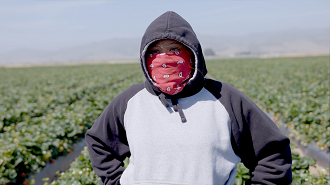
Fruits of Labor 2021
Distributed by Grasshopper Film, 12 East 32nd St., 4th Floor, New York, NY 10016
Produced by Tracy Rector, Aurora Guerrero, and Richard Ray Perez
Directed by Emily Cohen Ibañez
Streaming, 88 mins
High School - General Adult
Agriculture; Child Labor; Latin Americans
Date Entered: 03/01/2022
Reviewed by Andy Horbal, Cornell University LibraryIn her short story “The Ones Who Walk Away from Omelas,” Ursula Le Guin describes a paradisiacal city fueled by the suffering of an innocent child. “They all know it is there, all the people of Omelas,” Le Guin writes, and “they all understand that their happiness, the beauty of the city, the tenderness of their friendships, the health of their children, the wisdom of their scholars, the skill of their makers, even the abundance of their harvest and the kindly weathers of their skies, depend wholly on this child’s abominable misery.” The title refers to the citizens who decide that they will not accept this bargain and leave.
Many documentaries are, at their essence, attempts to awaken the inhabitants of our own Omelas to the high price of the creature comforts we enjoy every day without really thinking about where they came from. Take, for instance, the strawberries we can find year-round in the produce and freezer aisles of our local grocery stores, regardless of where in Canada or the United States we may live. Do we wonder who picked them, where they live, how old they are, or if they are being fairly compensated for their labor?
The goal of Fruits of Labor is to make sure we do from now on. Its hero is a teenager named Ashley Solis who is attempting to finish her final year of high school while also working the night shift at a processing plant in a California town which the locals call “Fresaville” (after the Spanish word for strawberry) to help her undocumented mother support her two siblings. Solis is obviously dripping with potential: she is smart, creative, community-minded, and responsible beyond her years. She is also frequently too tired to go to school because of her job, and consequently has racked up enough absences to jeopardize her graduation in the spring.
A classroom scene early in the movie makes it clear where director Emily Cohen Ibañez places the blame for this. FDR’s New Deal did not include protections for agricultural workers or domestic workers, including child laborers, which per the teacher giving the lesson “means that it completely perpetuated the exclusion of descendants of enslaved people for economic gains of the landowners” and explains “why we have so many people in our community and even your classmates who work in the fields.”
The press kit for Fruits of Labor explicitly connects Solis’s plight to the Trump administration’s crackdown on immigration. Cohen Ibañez explains that the idea for the film originated with her observation that when undocumented adults started to fear going to work in agricultural fields and factories that were vulnerable to ICE raids, their children had to replace them. This is never stated outright in the film itself, though, but instead takes more the form of a malevolent spirit lurking in the shadows. Yamil Rezc’s score uses heavy breathing, train whistles, ticking clock sounds, and high-pitched noises to create a stressful, uneasy mood, while audio clips of news coverage and scenes of Solis and her mother huddled over a phone and talking about neighbors who have been taken away evoke the specific things they’re worried about.
Fruits of Labor is just as committed to celebrating Solis’s triumphs as it is to depicting the challenges she faces, and for every moment like the ones described above there’s another showing her enjoying a quiet moment with her boyfriend (with whom she appears to have a healthy, adult relationship) or killing a presentation about a community garden she helped create. There’s also quite a bit of discussion about the fact that her brother, who’s only two years younger than her, is held to an entirely different standard. “While he has fun in his fantasy world, I have to work day and night,” Solis says. These portions of the film are rife with poetic imagery such as time-lapse footage of strawberries ripening on the vine, flowers blooming, and butterflies emerging from their chrysalises.
Whether these two aspects of Fruits of Labor support or are in conflict with each other is an open question. On the one hand, seeing how much Solis is able to accomplish even with the odds stacked against her cannot help but make us wonder how much more she’d be able to achieve if she was free, as she puts it, “to only worry about the things girls worry about at [her] age.” Anyone who believes that the whole point of school is to help our youth realize their full potential as citizens and human beings should be outraged. On the other hand, everyone in Omelas knows about the child, but more people stay than leave because they are adept at rationalizing its suffering: “even if the child could be released, it would not get much good of its freedom,” they tell themselves. A skeptical viewer might similarly argue that Ashley’s comments about, say, her brother point to problems that would still exist even under different circumstances.
None of this necessarily affects the film’s potential value to an educator. After all, the choices that Cohen Ibañez and Solis, who is credited as a co-writer, make are themselves worthy of discussion, as is Cohen Ibañez’s strategy of collaborating with her primary subject. In the meantime, it’s hard to imagine anyone objecting to spending eighty minutes in the company of a remarkable young woman like Ashley Solis.
Published and licensed under the Creative Commons Attribution 4.0 license. Anyone can use these reviews, so long as they comply with the terms of the license.